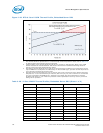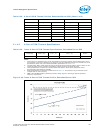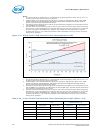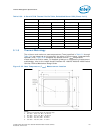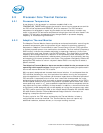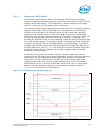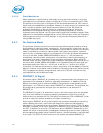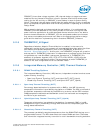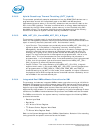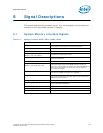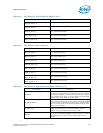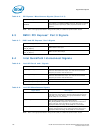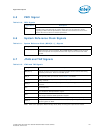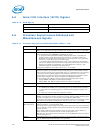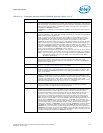
142 Intel® Xeon® Processor E5-1600/E5-2600/E5-4600 Product Families
Datasheet Volume One
5.2.6.2 Hybrid Closed Loop Thermal Throttling (CLTT_Hybrid)
The processor periodically samples temperature from the DIMM TSoD devices over a
programmable interval and interpolates gaps or the BMC/Intel ME samples a
motherboard thermal sensor in the memory subsection and provides this data to the
PCU via the PECI interface. This data is combined with an energy based estimations
calculated by the PCU. When needed, system memory is then throttled using CAS
bandwidth control. The processor supports dynamic reprogramming of the memory
thermal limits based on system thermal state by the BMC or Intel ME.
5.2.6.3 MEM_HOT_C01_N and MEM_HOT_C23_N Signal
The processor includes a pair of new bi-directional memory thermal status signals
useful for manageability schemes. Each signal presents and receives thermal status for
a pair of memory channels (channels 0 and 1 and channels 2 and 3).
• Input Function: The processor can periodically sense the MEM_HOT_{C01/C23}_N
signals to detect if the platform is requesting a memory throttling event.
Manageability hardware could drive this signal due to a memory voltage regulator
thermal or electrical issue or because of a detected system thermal event (for
example, fan is going to fail) other system devices are exceeding their thermal
target. The input sense period of these signals are programmable, 100 us is the
default value. The input sense assertion time recognized by the processor is
programmable, 1 us is the default value. If the sense assertion time is programmed
to zero, then the processor ignores all external assertions of MEM_HOT_{C01/
C23}_N signals (in effect they become outputs).
• Output Function: The output behavior of the MEM_HOT_{C01/C23}_N signals
supports Level mode. In this mode, MEM_HOT_{C01/C23}_N event temperatures
are programmable via TEMP_OEM_HI, TEMP_LOW, TEMP_MID, and TEMP_HI
threshold settings in the iMC. In Level mode, when asserted, the signal indicates to
the platform that a BIOS-configured thermal threshold has been reached by one or
more DIMMs in the covered channel pair.
5.2.6.4 Integrated Dual SMBus Master Controllers for SMI
The processor includes two integrated SMBus master controllers running at 100 KHz for
dedicated PCU access to the serial presence detect (SPD) devices and thermal sensors
(TSoD) on the DIMMs. Each controller is responsible for a pair of memory channels and
supports up to eight SMBus slave devices. Note that clock-low stretching is not
supported by the processor. To avoid design complexity and minimize package C-state
transitions, the SMBus interface between the processor and DIMMs must be connected.
The SMBus controllers for the system memory interface support the following SMBus
protocols/commands:
• Random byte Read
•Byte Write
•I
2
C* Write to Pointer Register
•I
2
C Present Pointer Register Word Read
•I
2
C Pointer Write Register Read.
Refer to the
System Management Bus (SMBus) Specification, Revision 2.0 for standing
timing protocols and specific command structure details.
§



